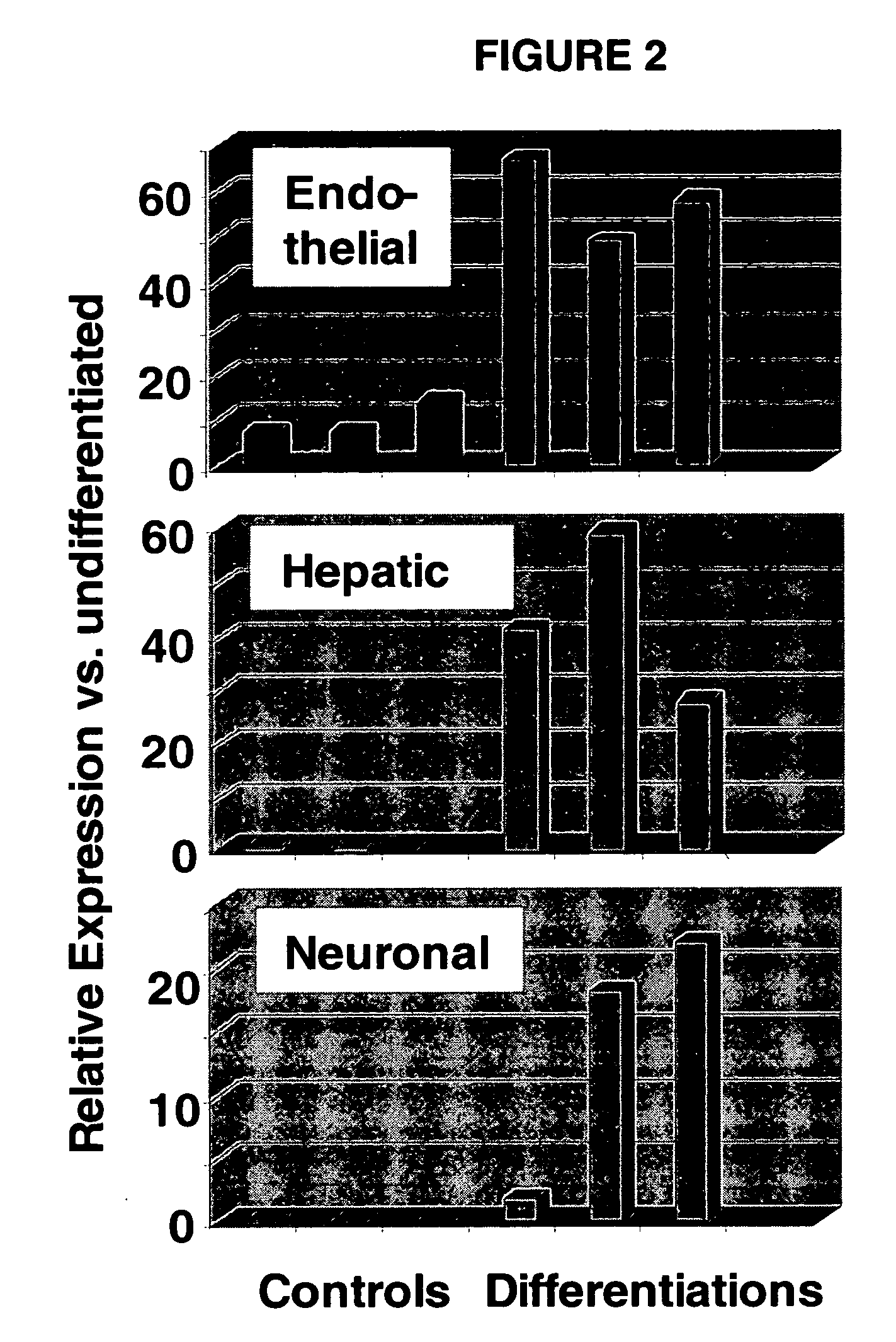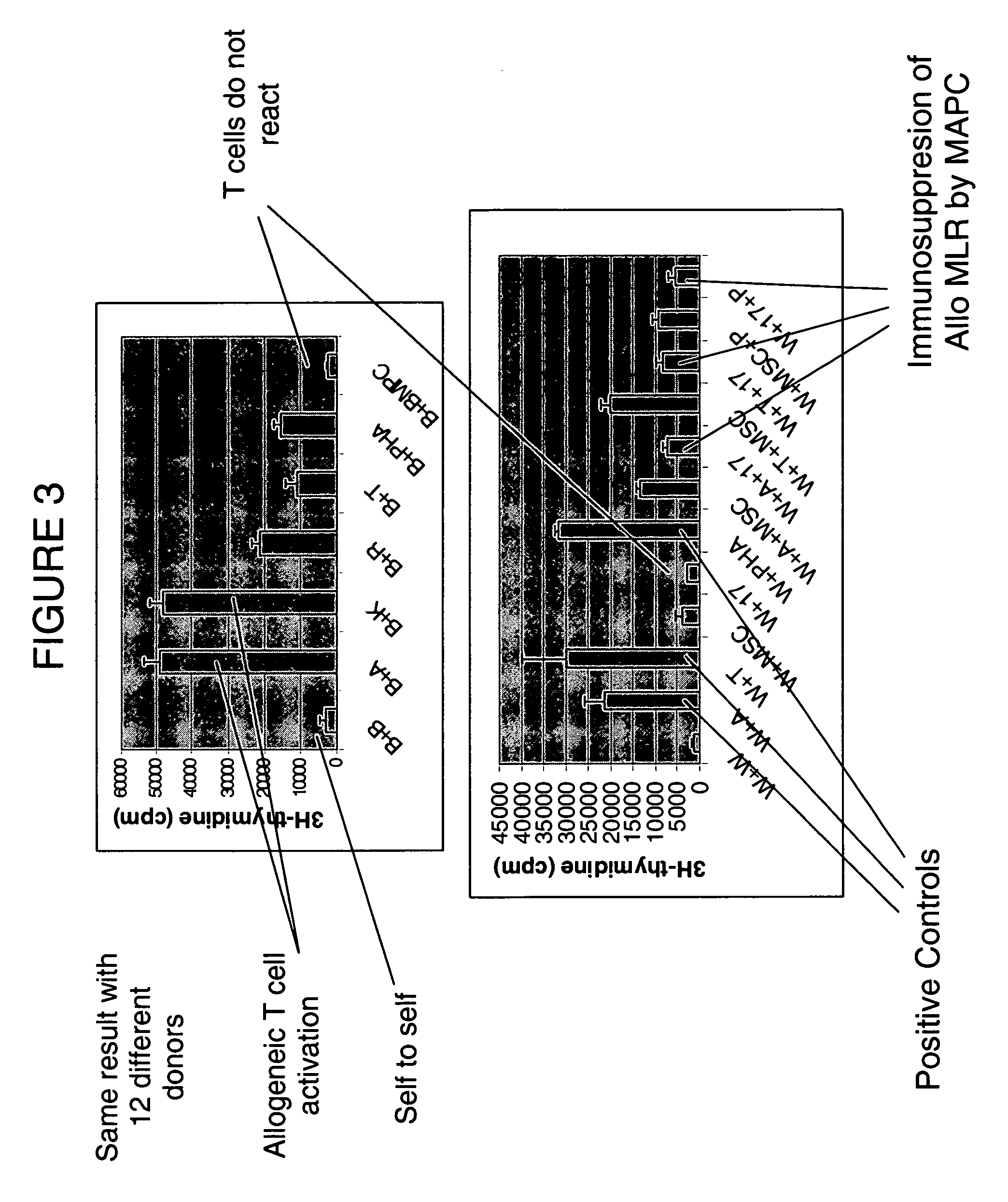Immunomodulatory properties of multipotent adult progenitor cells and uses thereof
a technology of adult progenitor cells and immunomodulatory properties, which is applied in the direction of immunological disorders, extracellular fluid disorders, antibody medical ingredients, etc., can solve the problems of complex therapeutic uses of transplantation, ineffectiveness, and inability to effectively treat host tissue, etc., to achieve the effect of treating immune dysfunction
- Summary
- Abstract
- Description
- Claims
- Application Information
AI Technical Summary
Benefits of technology
Problems solved by technology
Method used
Image
Examples
example 1
Human MAPCs (from Bone Marrow Mononuclear Cells)
[0381] Bone morrow mononuclear cells were obtained from bone marrow aspirates from the posterior iliac crest of >80 healthy human volunteers. Ten to 100 cubic centimeters of bone marrow was obtained from each subject, as shown in Table 2, which indicates the approximate number of mononuclear cells isolated from each subject. Mononuclear cells (“MNCs”) were obtained from bone marrow by centrifugation over a Ficoll-Paque density gradient (Sigma Chemical Co., St Louis, Mo.). Bone marrow MNCs were incubated with CD45 and Glycophorin A microbeads (Miltenyi Biotec, Sunnyvale, Calif.) for 15 minutes and CD45+GlyA+ cells removed by placing the sample in front of a SuperMACS magnet. The eluted cells are 99.5% CD45−GlyA−.
[0382] As shown in Table 2, depletion of CD45+GlyA+ cells resulted in recovery of CD45− GlyA− cells which constituted approximately 0.05 to 0.10% of the total bone marrow mononuclear cells.
TABLE 2Number of MAPCs in Human Bon...
example 2
Mouse MAPCs
[0388] All tissues were obtained according to guidelines from the University of Minnesota IACUC. BM mononuclear cells (BMMNC) were obtained by Ficoll Hypaque separation. BM was obtained from 5-6 week old ROSA26 mice or C57 / BL6 mice. Alternatively, muscle and brain tissue was obtained from 3-day old 129 mice. Muscles from the proximal parts of fore and hind limbs were excised and thoroughly minced. The tissue was treated with 0.2% collagenase (Sigma Chemical Co., St Louis, Mo.) for 1 hour at 37° C., followed by 0.1% trypsin (Invitrogen, Grand Island, N.Y.) for 45 minutes. Cells were then triturated vigorously and passed through a 70 μm filter. Cell suspensions were collected and centrifuged for 10 minutes at 1600 rpm. Brain tissue was dissected and minced thoroughly. Cells were dissociated by incubation with 0.1% trypsin and 0.1% DNAse (Sigma) for 30 minutes at 37° C. Cells were then triturated vigorously and passed through a 70 μm filter. Cell suspensions were collected ...
example 3
Rat MAPCs
[0395] BM and MNCs from Sprague Dawley, Lewis, or Wistar rats were obtained and plated under conditions similar to those described for mMAPCs. After 21-28 days, cells were depleted of CD45+ cells, and the resulting CD45− cells were subcultured at 10 cells / well.
[0396] Similar to mMAPCs, rMAPCs have been culture expanded for >100 PDs. Expansion conditions for rat MAPC culture required the addition of EGF, PDGF-BB, and LWF, and culture on FN, but not collagen type I, laminin, or Matrigel™.
[0397] Rat MAPCs that had undergone 42 PDs, 72 PDs, 80 PDs, and 100 PDs, were harvested and telomere lengths evaluated. Telomeres did not shorten in culture, as determined by Southern blot analysis after 42 PDs, 72 PDs, 80 PDs, and 100 PDs. Monthly cytogenetic analysis of rat MAPCs revealed normal karyotype.
PUM
| Property | Measurement | Unit |
|---|---|---|
| cell-doubling time | aaaaa | aaaaa |
| concentrations | aaaaa | aaaaa |
| concentrations | aaaaa | aaaaa |
Abstract
Description
Claims
Application Information
 Login to View More
Login to View More - R&D
- Intellectual Property
- Life Sciences
- Materials
- Tech Scout
- Unparalleled Data Quality
- Higher Quality Content
- 60% Fewer Hallucinations
Browse by: Latest US Patents, China's latest patents, Technical Efficacy Thesaurus, Application Domain, Technology Topic, Popular Technical Reports.
© 2025 PatSnap. All rights reserved.Legal|Privacy policy|Modern Slavery Act Transparency Statement|Sitemap|About US| Contact US: help@patsnap.com



